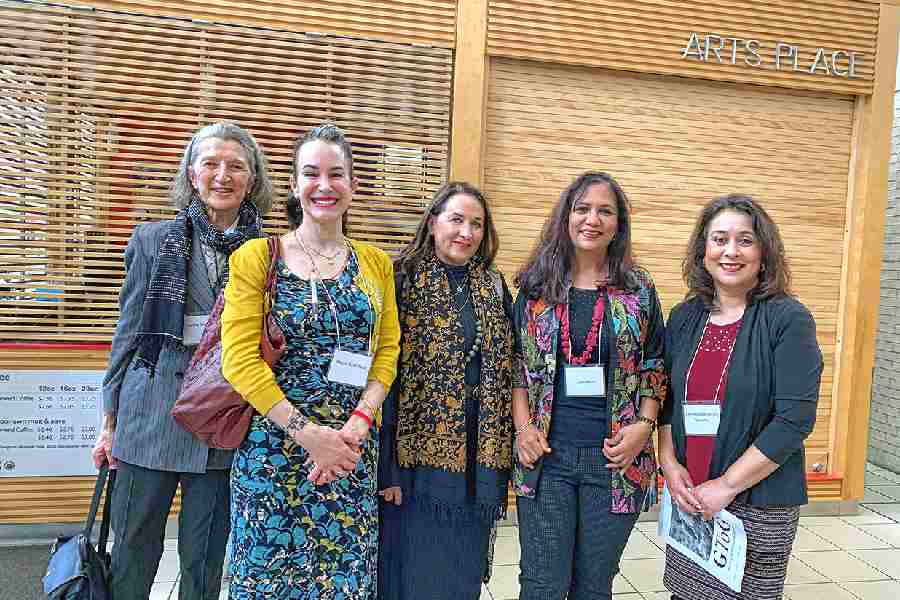It was a moment of great pride and honour for Kolkata-based kantha specialist Farah Khan to be invited to the recently held three-day symposium dedicated to women’s textile and garment production in Asia at the Art History and Visual Studies centre of the University of Victoria in British Columbia, Canada. Titled ‘Gendered Threads of Globalization: 20th c. Textile Crossings in Asia Pacific’, professor Melia Belli Bose of the said department hosted the symposium that united scholars, activists and artists from across North America, Asia and Europe to discuss intersections of gender, textiles/garments/fashion, labour and heritage across Asia during the 20th century.
“We hosted approximately 30 scholars, artists, and textile experts from various countries in Asia, Europe and North America. I conceived this conference to unite those working with heritage textile study, revival, and preservation in different Asian cultures. We focused on women’s roles as textile makers, cultural stewards, activists working for recognition and safe working conditions, and designers. The gendered angle is rooted in the fact that women have always had an integral role in textile production, from sericulture in East Asia to making nakshi kanthas in Bengal and phulkaris in Punjab to indigo in Southeast Asia,” said Melia Belli Bose, associate professor, South Asian Art History, University of Victoria, Canada, who was the main organiser of the symposium.
Farah Khan, who is an Army officer’s wife and has her one-stop kantha stores at Fort William and at Loudon Street, has been working with the artisans from rural Bengal for nearly two decades now. Her speciality lies in making this heritage craft of Bengal more contemporary, versatile and accessible with design innovations. “I started my business from Kashmir with Kashmiri shawls but somehow Bengal attracted me. When I started my journey with kantha, I felt it was not market-ready in terms of design and look. There were mostly tussore kanthas and quilts. I worked hard to make the craft popular by making it market-ready and adding the luxurious feel to it. I travelled with it to various parts of the world to make the craft known to the rest of the world,” said Farah.
The three-day symposium included several panels, a screening of an award-winning documentary on kantha from Bangladesh called Threads and a textile-based performance by visual artiste Monica Jahan Bose. The keynote address was delivered by Ashoka Fellow Judy Frater who has been working on contemporary textiles with women embroiderers of Kutch for 30 years. Farah spoke in the panel titled Bengal — Problems, Possibilities, and Hope, along with fellow panellists Sanchita Banerjee Saxena, executive director at Institute for South Asian Studies, University of California, Berkeley, and filmmaker Cathy Stevulak.
Farah’s talk was about the state of kantha in West Bengal, her journey involving efforts to change the conventional perspective on kantha and to improve the livelihoods of the artisan community, extensively involving women. “I gave a presentation on the status of kantha hand embroidery — its origins, how it underwent a change over the last 100 years, what has been done to uplift kantha and what more needs to be done to increase its awareness and improve its standing amongst the world of hand embroideries. My aim for the trip and the presentation was to popularise kantha internationally. Since they were textile experts, they knew about kantha but did not know it was so luxurious because of how it has mostly been marketed as quilts and tussore sari. At the symposium, I talked about the improvement of Bengal tourism through kantha and the polarisation of being either extremely cheap or expensive as the reason behind its less popularity so far. Unless we have huge production and employment of artisans, the polarisation issue with price won’t be solved,” said Farah Khan.
While Sanchita Banerjee Saxena presented her findings from her extensive study on garment factory workers in Asia, Cathy’s film featuring Bangladesh’s Surayia Rahman and her group of artisans narrated the story of kantha revival in the early 1980s, the creation of nakshi kantha tapestries and how the craft paved the way for economic independence of women in Bangladesh adding to the national economy. “It was a special gathering of scholars and practitioners to share experiences about the benefits, challenges and value of artisan enterprise and garment industries. It was my privilege to co-present the film and my research about kantha. We discussed ways to encourage artisan enterprise and to bring the beauty of handcraft to more homes, schools, and public and private institutions,” said Cathy Stevulak. Sanchita Banerjee Saxena, added, “I was happy to share my work about working conditions in garment supply chains with this group of speakers and the audience. It is essential that we critically understand the labour behind the various forms of crafts, costumes, and clothing that are being produced throughout Asia that were discussed over the three days.” At the end of the panel discussion, Farah presented her kantha work to show the progress from a simple running stitch to a very intricate form of hand embroidery over the years.
